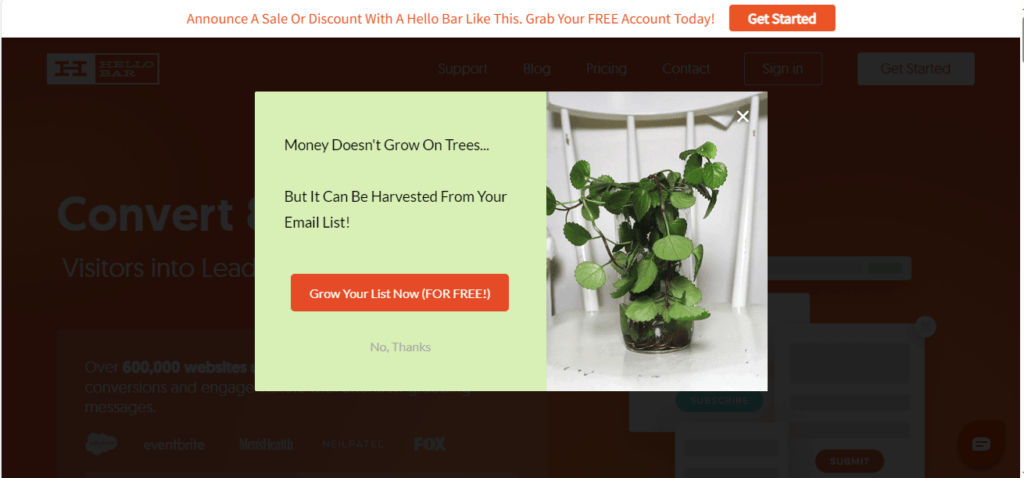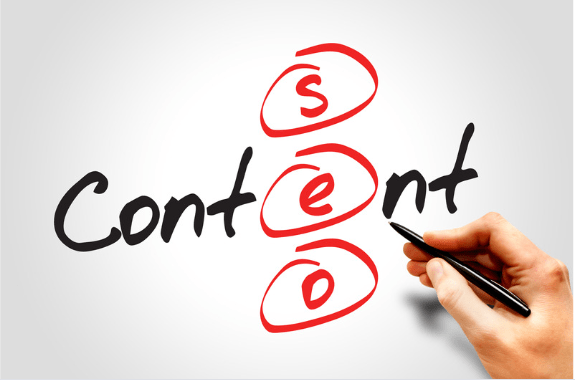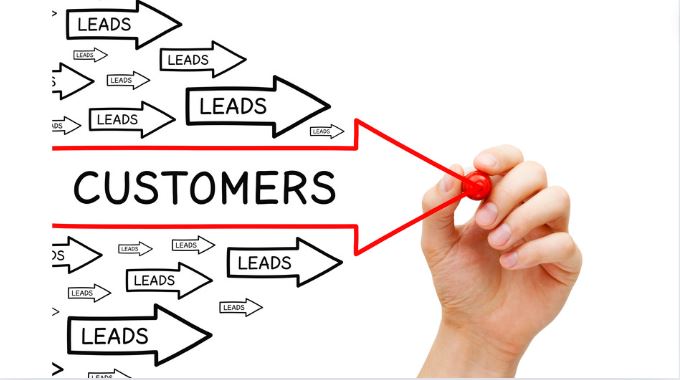Getting More Leads from Your Blog Traffic: Tactics for 2025

I hope you enjoy this blog post. If you want Hello Bar to grow your leads, click here.
Author:
Ryan Bettencourt
Published
August 1, 2024

Do people still read blogs? Most marketers ask this question wondering if they should still invest in content marketing.
A recent study by HubSpot asked the same question and found positive results. The study shows that 29% of respondents read blogs between once and four times a month, while 18% read them every day.
It’s evident that customers like reading informative content.
Unlike in the past, when people used to buy things based on ads, customers nowadays are more informed and want to make sure that they’re buying the right product.
That’s where your blog comes in.
By writing informative blog posts, you can attract more leads and convert them into customers.
But how do you convert blog traffic into leads?
Here’s an overview of getting more leads from your blog traffic.
You May Also Like:
- 9 Strategies on How to Generate Leads from Your Website
- 11 Best B2B Lead Generation Strategies of 2025
What Blogs Get the Most Traffic?
Some businesses blog just for the sake of it.
But that’s not going to take you anywhere.
If you want to get more leads from your blog traffic, you need to make sure that your blog posts are interesting and informative. They should add value to your readers’ lives.
Readers should either be able to learn something new from your blog post or be entertained by it.
Here are some ideas for blog posts that tend to generate more traffic:
- How-to guides
- Lists
- Case studies
- Expert opinions
- Original research
- Interviews
Are Blogs Effective in Generating Leads?
Content marketing, particularly blogging, is a great way to generate leads because it helps you establish your brand as a trusted authority in your industry.
When you provide helpful information through your blog posts, you demonstrate your expertise and build credibility with your audience.
As readers engage with your content, they’re more likely to see you as a reliable source. They’ll also consider your products or services when they’re ready to make a purchase.
Moreover, well-written blog posts can be optimized for search engines, making it easier for potential customers to find your website. This increased visibility can lead to more traffic and, ultimately, more leads.
Additionally, blog posts can be shared on social media platforms, allowing you to reach a wider audience and engage with potential customers in a more personal way.
You May Also Like:
How Do You Convert Blog Readers to Leads?

Every business wants a high traffic blog.
However, traffic doesn’t necessarily translate into more leads.
To convert blog readers to leads, you’ll need a few things: a good call to action (CTA), an optimized lead capture form, and valuable content that your readers can benefit from.
Working in tandem with a web design company can ensure that your CTA placement, lead capture form, and overall blog design are finely tuned for maximum conversion potential.
Ideally, your blog posts should have at least one CTA in them. It may link to your product page or an opt-in form.
Also, your lead capture form shouldn’t be intrusive and ideally be placed above the fold.
Most importantly, make sure that your blog posts are well-written and interesting enough for readers to want to sign up with you.
Here’s how to convert blog traffic into sales:
Step 1: Identify Your Target Audience
The first step to getting more leads from your blog traffic is identifying your target audience.
You need to know who you’re writing for and what interests them.
Only then can you create content that appeals to them.
To find out who your target audience is, you can use Google Analytics.
It provides a wealth of information about your blog visitors, including their demographics and interests.
Additionally, you must show the right message to the right audience at the right time.
With HelloBar, you can target visitors by country, state, and city.
Likewise, you can target them by the campaign, source, ad, medium, and other parameters.
Step 2: Create Interesting and Informative Posts

Once you know your target audience, the next step to lead generation is to create interesting posts they’ll enjoy reading. However, creating content that resonates with your audience requires a strategic approach.
Let’s break down the process:
Keyword Research
Thoroughly researching relevant keywords is the first stage in writing engaging blog content.
Identify the keywords and phrases your target audience is using to search for information related to your industry. This will help you create content that aligns with their needs and interests.
Brainstorm Topics
Once you understand your target audience’s search habits, you can brainstorm a list of potential topics.
Consider addressing the common pain points of your readers, answering frequently asked questions, or providing insights into industry trends.
Write to Showcase Your Expertise
When crafting your blog posts, focus on showcasing your expertise and providing value to your readers.
Use clear, concise language. Also, ensure that your content is well-researched and informative.
Discuss Industry Trends
Stay up to date with your industry’s latest trends and developments, so you can incorporate this information into your blog posts.
Doing so will demonstrate your knowledge and help position you as a thought leader.
Optimize for Search Engines
Ensure your blog posts are optimized for search engines.
You can do this by incorporating relevant keywords, using descriptive titles and meta descriptions, and structuring your content to make it easy for search engines to crawl and index.
Engage with Your Audience
Encourage readers to interact with your content by asking questions, inviting comments, and responding to feedback.
It will help you connect with people and make them feel like they’re part of a community around your brand.
You May Also Like:
Step 3: Use Popups

You can show different CTAs to different visitors by using popups.
The strategic use of popups can convert your blog traffic into leads and sales.
For example, if your conversions are low from a specific country or region, you can try showing popups with localized promotions or those in the visitor’s native language.
Likewise, you can use popups to show different offers to first-time and returning visitors. HelloBar provides different types of popups to capture the attention of your blog visitors.
Here are some popular ones:
- Modals: These popups appear over your blog post and can be customized to match your brand.
- Bars: These are persistent popups that scroll down or up as your visitors do.
- Alerts: You can also use floating messages to enhance user engagement and alert visitors about updates.
Step 4: Leverage Internal Linking
Internal linking is your ally when it comes to converting blog traffic.
By strategically linking to other relevant posts on your site, you can boost the overall authority of your blog and increase conversions.
Here are a few ways to go about doing this:
- Incorporate CTAs Within Your Post: A CTA is a prompt that encourages readers to take a specific action, such as signing up for a newsletter, downloading a resource, or visiting a particular page. Link directly to landing pages or other relevant content.
- Leverage Your Blog Author Bio: The author bio is a short section that typically appears at the end of a blog post to provide information about the author. You can use this as a way to link back to highly authoritative posts that you’ve written.
- Create Custom Anchor Text: Anchor text is the clickable text in a hyperlink. Custom anchor text means creating specific, descriptive phrases that provide context about the linked page.
- Create custom anchor text for the links in your post and use it throughout the copy to make your site more search engine-friendly.
Step 5: Analyze Your Results and Iterate
Finally, no matter what tactics you use to convert blog traffic, you need to analyze your results to see what’s working and what’s not.
This will help you fine-tune your approach and get even better results over time.
You can use Google Analytics to track your progress and see how your blog posts are performing. If you’re using popups, you can also use HelloBar’s tracking and optimization features to monitor the performance of your campaigns.
Depending on the metrics you choose, you can analyze your campaign performance and see if there’s room for improvement anywhere.
Similarly, you can create custom reports with business-relevant data so you can make data-driven decisions.
HelloBar also facilitates A/B testing, allowing you to find better-performing lead generation techniques.
You May Also Like:
- 650+ Power Words List to Insanely Boost Conversions and Sales
- Copywriting Tips: 23 Ultra Effective Steps to Increase Conversions
Best Practices for Converting Blog Traffic
Now that you know how to convert blog traffic into high-quality leads, here are a few best practices to keep in mind:
1. Align with Your SEO Strategy

Ensure that your blog content aligns with your overall SEO strategy to generate leads.
To ensure this, start by conducting thorough keyword research to identify the topics and terms your target audience is searching for. Incorporate these high-intent keywords into your blog content to improve visibility and search results ranking.
Create long-form, informative content like blog posts, guides, and case studies that provide value to your readers. Optimize this content for SEO by using relevant headers, meta tags, meta descriptions, and internal linking.
You can also promote your content through various channels to build backlinks and social shares.
Continuously monitor your content’s performance using analytics tools, and refine your strategy based on data-driven insights.
2. Create Topic Clusters
Topic clusters are groups of interconnected web pages covering a specific theme. They help search engines understand your website’s expertise and guide visitors to easily find relevant information—a fundamental strategy taught in top blogging courses like Blog Growth Engine and Fat Stacks
To create topic clusters that drive more leads from your blog traffic, you can start by identifying your pillar topics. These are the broad, high-level subjects that are highly relevant to your target audience.
For each pillar topic, conduct keyword research to uncover related subtopics.
Next, create a comprehensive pillar page that covers the main topic in depth. Then, build a cluster of interconnected articles that dive deeper into each subtopic.
Strategically link these cluster pages back to the pillar page, and link between the cluster pages as well.
Optimize all content for SEO by incorporating relevant keywords, internal links, and other on-page elements. This will help search engines understand the hierarchy and authority of your topic cluster.
3. Include Engaging Lead Magnets

Lead magnets are valuable resources that you offer in exchange for a visitor’s contact information, such as an email address.
To effectively create a lead magnet, align it with your blog topic. For instance, if you’re a fitness blogger, offer a “7-Day Workout Plan” or a “Nutrition Guide”.
To use lead magnets to generate more leads from your blog traffic, you need to:
- Identify Your Audience’s Needs: Understand the main pain points or challenges your audience faces. Then, create lead magnets that solve these specific problems.
- Offer High-Value Content: Provide valuable resources, such as e-books, checklists, webinars, quizzes, and templates, that are relevant and actionable.
- Optimize Your Call to Action: Craft compelling CTAs that clearly communicate the benefits of your lead magnet and encourage visitors to take action.
- Leverage Unique Selling Propositions: Highlight what makes your brand unique and emphasize the value your lead magnet offers.
- Promote Your Lead Magnet: Use social media, email marketing, and partnerships to promote your lead magnets and attract more visitors to your blog.
4. Create Content for Different Stages of the Sales Funnel

Create content that addresses each stage of the sales funnel. At the top of the funnel (awareness), focus on educational, informative content like blog posts, videos, and guides that address your audience’s pain points and questions. This helps build brand awareness and trust.
In the middle of the funnel (consideration), provide more in-depth, value-added content like webinars, case studies, and product demos. This content should nurture leads and move them closer to a purchase decision.
At the bottom of the funnel (decision), create content that directly addresses objections and convinces leads to convert. This includes free trials, consultations, and personalized product recommendations.
Strategically place relevant lead magnets throughout your content to capture and nurture leads. Lastly, continuously analyze performance and refine your content strategy to optimize conversions at each stage of the funnel.
You May Also Like:
- Email Marketing For Beginners: A Complete Guide
- SEO For Lead Generation: How To Skyrocket Organic Leads
5. Optimize for All Devices
Ensure that your blog is optimized for mobile devices. As more people access content on their smartphones and tablets, it’s crucial that your blog looks great and functions smoothly on all screen sizes.
Use responsive design techniques. Then, test your blog on various devices to ensure a seamless user experience.
For instance, you can use a mobile-friendly website builder or content management system that automatically adjusts content layout to fit different screen sizes.
Additionally, you can optimize your images, videos, and other media to load quickly on mobile devices. This provides a fast and enjoyable browsing experience for your readers.
6. Incorporate Floating Bars
Floating bars are eye-catching elements that remain visible as a user scrolls down the page.
Use them to promote your lead magnets, highlight special offers, or encourage readers to take action.
Take a look at how Hello Bar has created a simple floating bar to grab the attention of its website visitors.

As the reader scrolls through your content, the floating bar will remain in view, making it easy for them to access the offer and convert.
7. Repurpose Your Content
Get more mileage out of your existing content by repurposing it into different formats.
Turn blog posts into videos, podcasts, or infographics. Compile related posts into an e-book or whitepaper. By repurposing your content, you can reach new audiences and extend the lifespan of your hard work.
For instance, if you’ve written a comprehensive blog post on “The Ultimate Guide to Starting a Successful Ecommerce Business,” you could turn it into a video series, a podcast episode, and an informative infographic.
This will allow you to present the same valuable information in multiple formats and cater to the preferences of your diverse audience. This will also increase the chances of them engaging with your content and turning into a lead.
You May Also Like:
- How to Build an Email List From Scratch: Start-to-Finish Guide
- How to Nurture Leads: Tactics and Experts Tips for 2025
8. Host Surveys and Giveaways
Engage your audience by hosting surveys and giveaways on your blog. Surveys can help you gather valuable feedback and insights about your readers’ interests and pain points.
Giveaways, on the other hand, can help you attract new subscribers and build brand awareness. Offer prizes that are relevant to your niche. You can also encourage participation by requiring entrants to share your giveaway on social media.
For example, if you’re a beauty brand, you could run a survey asking your blog readers about their skincare concerns and preferences. Then, use that data to shape your product development and content strategy.
Alternatively, you could host a giveaway for a free skincare set, requiring participants to follow your brand on social media and share the giveaway post to enter.
9. Use Chatbots to Engage Your Visitors

Chatbots are AI-powered tools that can engage with your visitors in real time. They can provide instant answers to questions and guide site visitors through your sales funnel.
Use chatbots to offer personalized recommendations, answer commonly asked questions, and collect lead information. They can provide a seamless and engaging user experience to help you convert more visitors into customers.
For instance, if you’re an ecommerce store selling home decor products, you could add a chatbot on your blog that asks visitors about their design preferences and recommends relevant products based on their responses.
This helps engage your audience and collects valuable data that can be used to personalize their shopping experience and increase conversions.
10. Include an Opt-in Form, Always
Make sure to include an opt-in form on every page of your blog. This helps you grow your email list so you can provide updates, exclusive content, or special offers.
Place your opt-in form in a prominent location, such as the sidebar or above the fold, and use compelling copy to encourage sign-ups. By building a strong email list, you can nurture your leads and turn them into loyal customers over time.
For example, you can create a simple opt-in form with a clear call-to-action button that says, “Join our newsletter and get 10% off your first purchase!”
This will incentivize visitors to subscribe, providing you with valuable leads that you can nurture through your email marketing campaigns.
You May Also Like:
- Customer Journey Maps – A Complete Guide to Help You Create Yours
- How Long Does It Take to Build a Website? Everything You Need
11. Create a Sense of Urgency
It’s important to include a sense of urgency in CTAs to encourage visitors to take the desired action.
This technique taps into the psychological principle of scarcity, where people are more likely to act quickly when they perceive an opportunity as limited or fleeting.
Here are ways to create a sense of urgency to generate more leads:
- Use Time-Sensitive Language: Incorporate these phrases into your CTAs to encourage immediate action.
Example: “Sign up now and get 50% off your first purchase” suggests that the discount is a special, time-limited deal.
- Highlight Limited Availability: By indicating that the offer is available only in limited quantities, you create a sense of scarcity.
Example: “Claim your free trial before we run out of stock” implies that the free trials are limited and could run out soon.
- Set Deadlines: Adding a specific deadline to your offer can prompt visitors to take action more quickly.
Example: “Get 30% off – Offer ends at midnight” gives a clear and urgent deadline.
- Make Offers Exclusive: This adds an element of privilege and urgency.
Example: “Exclusive offer: 20% off for our email subscribers” makes the deal feel special and time-sensitive.
- Use Countdown Timers: Integrate countdown timers on your landing pages or in your emails to reinforce the urgency.
Example: A countdown timer showing “24:00:00 remaining” for a discount creates a visual cue that time is running out.
These techniques can significantly boost conversion rates, particularly if your target audience is a niche market where specific offers are highly relevant.
In addition, making the offer exclusive and limited in nature can increase your website conversion rate.
Ways to Expand Your Blog’s Reach

Knowing how to expand your blog’s reach is crucial for increasing visibility, attracting potential readers, and generating more traffic.
You reach a wider audience, which shows greater potential for engagement, building an online community, and ultimately achieving your blogging goals.
That said, here are ways you can expand your blog’s reach:
Invest in Social Media Marketing
Social media platforms like Twitter, LinkedIn, Instagram, and Facebook can help you drive traffic to your blog.
You can generate more leads by sharing your content on these platforms to expand your reach. What’s more, you can use social media tools to create and share engaging visuals with your blog posts.
This is especially effective if you’re targeting Millennials, who are known to like visual content.
Harness the Power of Newsletters
Newsletters are an excellent tool for regularly delivering content to your audience.
When users subscribe to your newsletter, they gain access to all content that’s exclusive only to newsletter subscribers.
If your newsletter contains content that piques your subscribers’ interest, it can directly drive traffic back to your blog.
To start, you need to conduct research to understand what type of content resonates with your target audience and tailor your newsletter accordingly.
Establish a regular schedule for sending out your newsletter and stick to it. Doing so will help your subscribers look forward to your newsletters, increasing the chances of them engaging with it and visiting your blog.
You May Also Like:
- 21 Proven Exit Popup Formulas That Will Increase Conversion Rates
- Hello New Templates! Introducing Hello Bar’s Newest Email Collection Templates
FAQ
Q1. How do I convert blog traffic to leads?
To convert blog traffic to leads, you must create engaging content that resonates with your audience, use clear calls to action, and offer valuable resources like e-books or webinars. Additionally, optimize your blog for search engines to attract more visitors.
Q2. How do I find out how much traffic my blog gets?
You can use analytics tools like Google Analytics. Simply sign up for an account, add the tracking code to your blog, and start tracking your visitors. You can also use other tools like WordPress plugins or third-party services.
Q3. How can I generate more leads?
Focus on creating high-quality, relevant content that resonates with your target audience. Use SEO to attract more visitors, and optimize your blog for conversions by using clear CTAs and forms.
Q4. Why is my blog not getting traffic?
If your blog isn’t getting enough traffic, it might be due to a lack of SEO optimization, poor content quality, or insufficient marketing efforts. Ensure your content is well-written, engaging, and optimized for search engines. Also, promote your blog through social media, email marketing, and other channels.
Q5. How long does it take to get blog traffic?
Depending on content quality, SEO, and promotion, it can take anywhere from a few days to several months to gain sufficient blog traffic. Consistency and patience are key, as building an audience takes time.
Final Words
Once you start getting visitors on your landing page, your next approach should be to convert them into paying customers.
While a call to action is imperative, it’s not the only way to convert blog traffic.
As we’ve explained in the article, you should also use social media tools, create a sense of urgency in your CTAs, try A/B testing, promote your free trials or offers, and use re-marketing to improve results.
By using these tactics along with a well-designed landing page, you can convert blog traffic into leads and customers more effectively.







